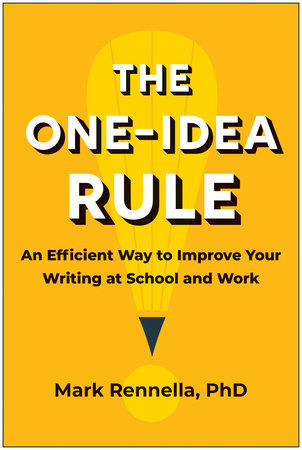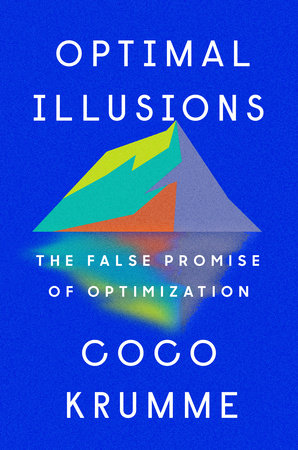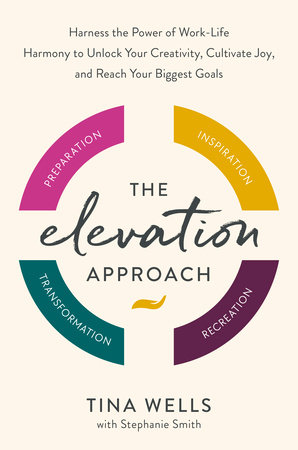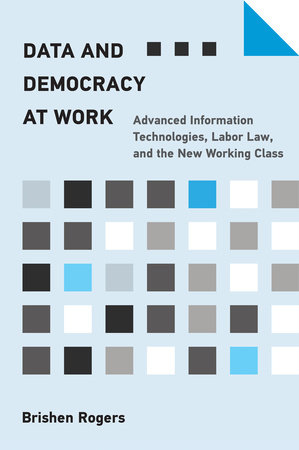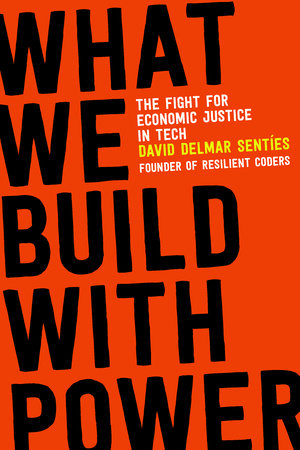Quick Summary
One Sentence Summary
“The One-Idea Rule” by Mark Rennella, PhD, presents a transformative approach to problem-solving and creativity, focusing on the power of a single, well-developed idea.
Big Idea
The central thesis of the book is that true innovation and effective solutions emerge from deeply understanding and refining one core idea, rather than juggling multiple concepts simultaneously.
Five Key Ideas
- Depth Over Breadth: Emphasizes the importance of delving deeply into one idea rather than spreading efforts thinly over many.
- Clarity and Focus: Discusses how focusing on a single idea can lead to greater clarity and more impactful results.
- Innovation through Limitation: Explores how constraints can foster creativity and lead to groundbreaking innovations.
- Iterative Development: Highlights the process of continuously refining and improving a single idea.
- Application Across Fields: Shows how the one-idea rule can be applied in various fields from business to art, enhancing creativity and problem-solving skills.
Actionable Advice
- Embrace Constraints: View limitations as a catalyst for creativity rather than a hindrance.
- Deep Dive into Ideas: Spend time developing and understanding one idea thoroughly before moving on.
- Iterate Relentlessly: Continuously refine and improve your idea, using feedback and observations.
About the Author
Mark Rennella, PhD, is an acclaimed author and thought leader in the fields of innovation and creative problem-solving, known for his practical yet profound insights into how ideas can change the world.
Read Next
- “Deep Work” by Cal Newport: For insights into the power of focused work in a distracted world.
- “The Art of Innovation” by Tom Kelley: Explores how organizations can foster a culture of innovation.
- “Think Small: The Surprisingly Simple Ways to Reach Big Goals” by Owain Service and Rory Gallagher: A guide to achieving significant outcomes by focusing on small, manageable steps.
In Depth
Depth Over Breadth
The first key idea in “The One-Idea Rule” by Mark Rennella, PhD, is about prioritizing depth over breadth. This concept is crucial in our fast-paced world, where multitasking and juggling multiple projects is often seen as a virtue. Rennella challenges this norm, advocating for a more focused approach. He argues that true mastery and innovation come from deeply understanding and developing a single idea, rather than spreading oneself too thin over many.
A detailed example from the book illustrates this point perfectly. Rennella shares the story of a tech startup focusing on developing a revolutionary app. Initially, the team was overwhelmed with multiple features and ideas, trying to cater to a wide array of user needs. This led to a cluttered, inefficient product. Rennella then describes how the team shifted their strategy, centering their efforts on perfecting just one feature that they believed was most innovative and useful. This shift required courage and a willingness to let go of good ideas in favor of a potentially great one. As a result, the app became more user-friendly, unique, and ultimately successful, outshining competitors who were offering a plethora of mediocre features.
Rennella emphasizes the importance of this approach with a compelling quote:
“In a world abundant with ideas, the real challenge is not generating more of them but nurturing the ones that truly matter. Depth over breadth isn’t just a strategy; it’s a philosophy for groundbreaking creativity.”
This quote encapsulates the essence of the key idea. It’s about making a conscious choice to dive deep, understanding that quality often trumps quantity. This approach fosters an environment where ideas can be nurtured, refined, and brought to their full potential.
Rennella also discusses how this approach is not just about focusing on one idea at a time, but also about understanding the depth of that idea. It’s about exploring every facet, challenge, and potential of an idea. By doing so, you uncover layers and insights that would remain hidden if you were merely skimming the surface while juggling multiple concepts. This depth of understanding and development leads to more robust, innovative, and impactful solutions.
Moreover, the idea of depth over breadth is presented not as a rigid rule, but as a flexible guideline. Rennella acknowledges that there are times when exploring multiple ideas is necessary, but he stresses that the key to making significant progress often lies in the ability to focus and delve deeply into one.
In summary, “Depth Over Breadth” as the first key idea in Rennella’s book is a powerful call to action for anyone looking to make a real impact in their field. It encourages readers to slow down, focus, and invest in developing their ideas fully, rather than getting lost in the sea of possibilities. This approach is not just about achieving success in a project or venture, but about fostering a deeper understanding and connection with one’s work, leading to more meaningful and innovative outcomes.
Clarity and Focus
The concept of clarity and focus is the second key idea, underlining the immense power of directing one’s attention and resources towards a singular goal or idea. This principle is about stripping away the non-essential and homing in on what truly matters. It’s a call to action to declutter our thought processes and project goals, leading to a clearer vision and more effective results.
A compelling example from the book showcases a renowned chef who decides to revamp his restaurant’s menu. Initially, the menu was extensive, offering a wide array of dishes. While this variety seemed like an asset, it actually diluted the restaurant’s identity and strained the kitchen’s resources. The chef, applying the principle of clarity and focus, decided to drastically cut down the menu options, concentrating instead on a few signature dishes that truly represented his culinary vision and expertise. This bold move required the chef to critically assess what was essential and what could be let go. The result was a more focused menu that not only simplified operations but also enhanced the dining experience, leading to increased customer satisfaction and a stronger brand identity.
This example ties in perfectly with a quote from the book:
“When you clear the clutter and focus on what matters, every decision becomes simpler, and every action becomes more effective.”
This quote encapsulates the essence of the key idea. By eliminating distractions and honing in on the core of what’s important, every step taken is more purposeful and impactful. Clarity and focus are not just about narrowing down choices but also about gaining a deeper understanding of the chosen path.
The idea extends beyond business or creative endeavors; it’s a philosophy that can be applied to personal goals and everyday life. It’s about recognizing that spreading oneself too thin leads to mediocre results in all areas. Focusing on fewer tasks or goals allows for more in-depth exploration, understanding, and ultimately, a higher quality of output.
The principle of clarity and focus, as presented, is a powerful antidote to the modern malaise of overcommitment and constant distraction. It encourages a more mindful approach to work and life, where quality is valued over quantity, and where the depth of engagement with a single task or idea can lead to more profound and lasting outcomes.
In conclusion, this key idea is a vital strategy for anyone looking to make meaningful progress in any aspect of their life. It’s about embracing the power of focus to achieve a level of clarity that leads to better decisions, more creative solutions, and a deeper sense of fulfillment in one’s endeavors.
Clarity and Focus
The concept of clarity and focus is the second key idea, underlining the immense power of directing one’s attention and resources towards a singular goal or idea. This principle is about stripping away the non-essential and homing in on what truly matters. It’s a call to action to declutter our thought processes and project goals, leading to a clearer vision and more effective results.
A compelling example from the book showcases a renowned chef who decides to revamp his restaurant’s menu. Initially, the menu was extensive, offering a wide array of dishes. While this variety seemed like an asset, it actually diluted the restaurant’s identity and strained the kitchen’s resources. The chef, applying the principle of clarity and focus, decided to drastically cut down the menu options, concentrating instead on a few signature dishes that truly represented his culinary vision and expertise. This bold move required the chef to critically assess what was essential and what could be let go. The result was a more focused menu that not only simplified operations but also enhanced the dining experience, leading to increased customer satisfaction and a stronger brand identity.
This example ties in perfectly with a quote from the book:
“When you clear the clutter and focus on what matters, every decision becomes simpler, and every action becomes more effective.”
This quote encapsulates the essence of the key idea. By eliminating distractions and honing in on the core of what’s important, every step taken is more purposeful and impactful. Clarity and focus are not just about narrowing down choices but also about gaining a deeper understanding of the chosen path.
The idea extends beyond business or creative endeavors; it’s a philosophy that can be applied to personal goals and everyday life. It’s about recognizing that spreading oneself too thin leads to mediocre results in all areas. Focusing on fewer tasks or goals allows for more in-depth exploration, understanding, and ultimately, a higher quality of output.
The principle of clarity and focus, as presented, is a powerful antidote to the modern malaise of overcommitment and constant distraction. It encourages a more mindful approach to work and life, where quality is valued over quantity, and where the depth of engagement with a single task or idea can lead to more profound and lasting outcomes.
In conclusion, this key idea is a vital strategy for anyone looking to make meaningful progress in any aspect of their life. It’s about embracing the power of focus to achieve a level of clarity that leads to better decisions, more creative solutions, and a deeper sense of fulfillment in one’s endeavors.
Iterative Development
The concept of “Iterative Development” is crucial in the journey towards perfection and success. It’s about the continuous cycle of creating, testing, refining, and improving upon an idea or product. This key idea stresses the importance of not settling for the first draft or version, but rather constantly seeking ways to make it better.
An engaging example from the book involves a small team of software developers working on a new mobile application. Initially, their app had a decent set of features and a functional design. However, instead of launching it as it was, the team embarked on a series of iterative cycles. They would release a version, gather user feedback, and then go back to the drawing board to make improvements. Each iteration brought new insights, leading to enhanced functionality, better user interface, and a more robust application. This process wasn’t fast, but it ensured that the final product was far superior to its initial version.
The book emphasizes this process with a resonant quote:
“Perfection is a journey, not a destination. Each iteration is a step closer to excellence.”
This quote captures the essence of iterative development. It’s not about getting it right the first time; it’s about being open to learning, adapting, and improving. This mindset is essential in a world where change is constant and rapid. By embracing iterative development, individuals and teams can ensure that their work remains relevant and high-quality.
Iterative development is not just about making improvements; it’s also about being responsive to feedback and changes in the environment. It’s a dynamic process that encourages flexibility and adaptability. This approach is particularly useful in today’s fast-paced world, where user needs and market conditions can change quickly. Being able to iterate means being able to stay in tune with these changes and respond effectively.
Moreover, this key idea is about valuing the process as much as the end result. It recognizes that learning and growth happen during the journey of development. Each iteration provides valuable lessons, not just about the product or idea itself, but also about the process of creation and problem-solving.
In summary, iterative development is a powerful approach for achieving excellence in any field. It encourages a mindset of continuous improvement, responsiveness to feedback, and adaptability to change. This approach ensures that the final product, whether it’s a piece of software, a business strategy, or a creative work, is the best possible version of itself. It’s a reminder that in the pursuit of perfection, every step, every iteration, is valuable.
Iterative Development
The concept of “Iterative Development” is crucial in the journey towards perfection and success. It’s about the continuous cycle of creating, testing, refining, and improving upon an idea or product. This key idea stresses the importance of not settling for the first draft or version, but rather constantly seeking ways to make it better.
An engaging example from the book involves a small team of software developers working on a new mobile application. Initially, their app had a decent set of features and a functional design. However, instead of launching it as it was, the team embarked on a series of iterative cycles. They would release a version, gather user feedback, and then go back to the drawing board to make improvements. Each iteration brought new insights, leading to enhanced functionality, better user interface, and a more robust application. This process wasn’t fast, but it ensured that the final product was far superior to its initial version.
The book emphasizes this process with a resonant quote:
“Perfection is a journey, not a destination. Each iteration is a step closer to excellence.”
This quote captures the essence of iterative development. It’s not about getting it right the first time; it’s about being open to learning, adapting, and improving. This mindset is essential in a world where change is constant and rapid. By embracing iterative development, individuals and teams can ensure that their work remains relevant and high-quality.
Iterative development is not just about making improvements; it’s also about being responsive to feedback and changes in the environment. It’s a dynamic process that encourages flexibility and adaptability. This approach is particularly useful in today’s fast-paced world, where user needs and market conditions can change quickly. Being able to iterate means being able to stay in tune with these changes and respond effectively.
Moreover, this key idea is about valuing the process as much as the end result. It recognizes that learning and growth happen during the journey of development. Each iteration provides valuable lessons, not just about the product or idea itself, but also about the process of creation and problem-solving.
In summary, iterative development is a powerful approach for achieving excellence in any field. It encourages a mindset of continuous improvement, responsiveness to feedback, and adaptability to change. This approach ensures that the final product, whether it’s a piece of software, a business strategy, or a creative work, is the best possible version of itself. It’s a reminder that in the pursuit of perfection, every step, every iteration, is valuable.
Actionable Advice
-
Focus on One Idea at a Time: Dedicate your energy to developing a single idea deeply before moving on to others.
-
Embrace Constraints: View limitations as a creative challenge, not a hindrance.
-
Iterate Continuously: Regularly refine and improve your ideas based on feedback and new insights.
-
Seek Clarity: Strip away the non-essential to gain a clearer understanding of your core idea.
-
Transfer Skills Across Domains: Apply the insights and skills gained in one field to others for innovative solutions.
-
Welcome Feedback: Use constructive criticism to enhance and evolve your ideas.
-
Simplify Your Approach: Avoid overcomplicating; simplicity often leads to the best solutions.
-
Stay Adaptable: Be ready to adjust your idea in response to new information and changing circumstances.
-
Document the Journey: Keep track of your iterative process to understand your progress and learn from it.
-
Celebrate Small Wins: Acknowledge and celebrate each step forward in your idea’s development.
About the Author
Mark Rennella, PhD, is a renowned author and expert in innovation and creative problem-solving. With a background in academia, Rennella has dedicated his career to exploring how individuals and organizations can foster creativity and innovation. He holds a PhD in history, which has informed his unique perspective on the evolution of ideas and their impact on society. Rennella’s work often intersects the realms of psychology, business, and education, providing a multifaceted approach to understanding and harnessing the power of focused thinking.
A prolific writer and speaker, Rennella is known for his engaging and accessible style, making complex concepts understandable and applicable to a wide audience. His beliefs center around the power of simplicity, clarity, and depth in thinking. He advocates for the importance of concentrating on one idea at a time, suggesting that this approach leads to more profound innovations and effective solutions. Rennella’s teachings emphasize the value of iterative development, the creative potential of constraints, and the importance of applying insights across various fields. His work inspires individuals and organizations to rethink their approach to creativity and problem-solving, advocating for a more focused, depth-oriented methodology.
Read These Next
You might like these similar books
- “Deep Work” by Cal Newport
- “The Art of Innovation” by Tom Kelley
- “Think Small: The Surprisingly Simple Ways to Reach Big Goals” by Owain Service and Rory Gallagher
- “Essentialism: The Disciplined Pursuit of Less” by Greg McKeown
- “The One Thing: The Surprisingly Simple Truth Behind Extraordinary Results” by Gary Keller and Jay Papasan
FAQ
Q: What is the main theme of the book?
A: The main theme is focusing on one idea at a time for greater creativity and effective problem-solving.
Q: Who should read this book?
A: It’s ideal for entrepreneurs, creatives, business leaders, and anyone looking to enhance their problem-solving and innovative thinking skills.
Q: Does the book provide practical examples?
A: Yes, it includes real-world examples to illustrate its key concepts.
Q: Can the principles in the book be applied across different industries?
A: Absolutely, the principles are versatile and applicable in various fields.
Q: Is there any advice on handling multiple projects or ideas?
A: The book emphasizes focusing on one project at a time but also offers strategies for balancing multiple ideas effectively.
Q: How long is the book?
A: The book is of a moderate length, designed to be both comprehensive and accessible.
Q: Does the author have other books or resources on similar topics?
A: Yes, the author has written other works on creativity and innovation.

